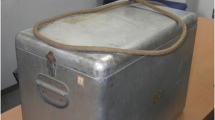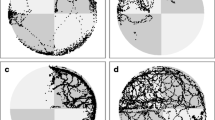Summary
Several operant conditioning procedures have been successfully used with the green crab, Carcinus maenas. Animals learned to press a bar for food reward and showed high rates of responding on a continuous reinforcement schedule or on a fixed ratio 2 schedule (every other response reinforced). Animals on a variable time schedule showed lower rates of responding. Crabs readily learned a spatial discrimination task in which one bar causes food to be dispensed (S+) and one is inactive (S-). The eye elevation system of the green crab can also be used in a yoked procedure using air puff to the eye as punishment. Master animals reduced the number of eye elevations after reflex withdrawal and showed longer latency compared to yoked controls. A delay introduced between response and punishment reduced the suppressing effect of the punishment.
Access this chapter
Tax calculation will be finalised at checkout
Purchases are for personal use only
Preview
Unable to display preview. Download preview PDF.
Similar content being viewed by others
References
Abramson, C. I. & Feinman, R. D. (1987). Operant Punishment in the Green Crab, Carduus maenas. Behav. Neural Biol. 48: 259–277.
Abramson, C. I. & Feinman, R. D. (1989). Lever Press Conditioning in the Green Crab. Soc. Neurosci. Abst. 15: 1141.
Becker, A. J., Jr. & Valinski, W. A. (1981). A method for BehaviorModification in Aquatic Crustaceans. Proc. West Virginia Acad. Sci. 53: 50–56.
Cuadras, J., Vila, E. & Balasch, J. (1978). T-Maze Shock Avoidance in the Hermit Crab Dardanus arrosor. Rev. Esp. de Fisiolog. 34: 273–276.
Denti, A., Dimant, B. & Maldonado, H. (1988). Passive Avoidance Learning in the Crab Chasmagnathus grauulatus. Phys. & Behav. 43: 317–320.
Dunn, P. D. C. & Barnes, W. J. P. (1981a). Learning of Leg Position in the Shore Crab, Carduus maenas. Mar. Behav. Physiol. 8: 67–82.
Dunn, P. D. C. & Barnes, W. J. P. (1981b). Neural Correlates of Leg Learning in the Shore Crab, Carduus maeuas. Mar. Behav. Physiol. 8: 83–97.
Forman, R. R. (1984). Leg position learning by an insect. I. A heat Avoidance Lerning Paradigm. J. Neurobiol. 15: 127–140.
Forman, R. & Zill, S. (1984). Leg position learning by an insect. II. Motor Strategies Underlying Learned Leg Extension. J. Neurobiol. 15: 221–237.
Horridge, G. A. (1962). Learning of leg position by headless insects. Nature 193: 697–698.
Hoyle, G. (1976). Learning of leg position by the ghost crab Ocypode ceratophthalma. Behav. Biol. 18: 147–163.
Hoyle, G. (1980). Learning, using natural reinforcements, in insect preparations that permit cellular neuronal analysis. J. Neurobiol. 11: 323–354.
Krasne, B. F. (1972). Learning in Crustacea, in Invertebrate Learning., 2, (ed. W. Corning, J. Dyal & A. O. D. Willows) pp. 49–130. Plenum Press.
Olson, G. S. & Strandberg, R. (1979). Instrumental Conditioning in crayfish: Lever Pulling for Food. Soc. for Neurosci. Abst., 257.
Punzo, F. (1983). Localization of brain function and neurochemical correlates of learning in the mud crab, Eurypauopeus depressus (Decapod). 75A: 299–305.
Rafuse, D. D. (1973). Morphological and physiological analysis of shock avoidance in the crab Hemigrapsus uudus.
Schöne, H. (1961). Learning in the spiny lobster Pauulirus argus. Biol. Bull. 121: 354–365.
Stafstrom, C. E. & Gerstein, G. L. (1977). A paradigm for position learning in the crayfish claw. Brain Res. 134: 185–190.
Tosney, T. & Hoyle, G. (1977). Computer-controlled learning in a simple system. Proc. Royal Soc. London Ser. B. 195: 365–393.
Author information
Authors and Affiliations
Editor information
Editors and Affiliations
Rights and permissions
Copyright information
© 1990 Springer Basel AG
About this chapter
Cite this chapter
Abramson, C.I., Feinman, R.D. (1990). Operant Conditioning in the Crab. In: Wiese, K., Krenz, WD., Tautz, J., Reichert, H., Mulloney, B. (eds) Frontiers in Crustacean Neurobiology. Advances in Life Sciences. Birkhäuser, Basel. https://doi.org/10.1007/978-3-0348-5689-8_24
Download citation
DOI: https://doi.org/10.1007/978-3-0348-5689-8_24
Publisher Name: Birkhäuser, Basel
Print ISBN: 978-3-0348-5691-1
Online ISBN: 978-3-0348-5689-8
eBook Packages: Springer Book Archive




